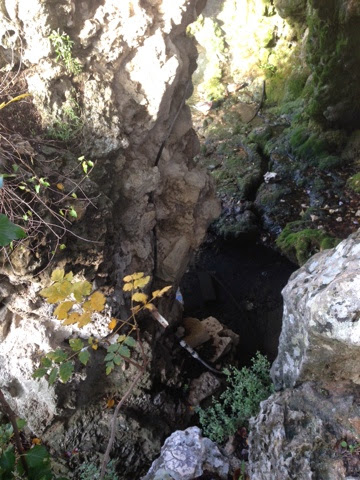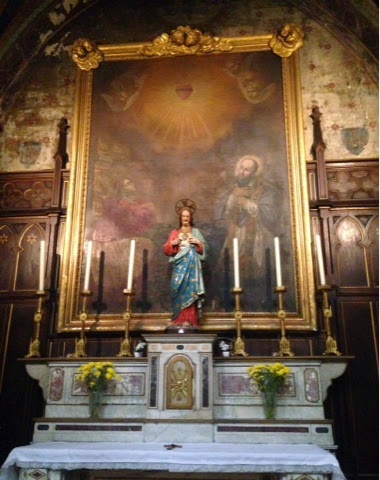"Avignon was born here. The vantage-point afforded by the rocky outcrop had already attracted inhabitants in the Neolithic era and it became an important settlement during the Roman occupation, while what later became the town proper began to grow at its feet
In the Middle Ages shepherds used the terrain for communal grazing and windmills were set up to take advantage of the Mistral, the fierce north-west wind that sweeps through this part of Provence.
As the cult of open-air exercise developed in the 18th century, the Rocher des Doms became a popular spot for strolling, and was fully landscaped in the 19th century. The park is seven acres and was designed around a large pond with swans, ducks, geese and carp. In the summer a snack bar is open. There are benches for the weary, picnic areas. two playgrounds and even toilets. You will also find an analemmati sundial and statues of local notables including Jean Althen , who introduced red madder-wort dye into the area paving the way for the production of les indiennes, the typical colorful fabrics of Provence.
And up and up we went!
The town of Villeneuve Lez Avignon is what you see in the distance. In the 10th century Saint Andrew Benedictine monastery was founded there. A small town grew up at the base and in the late 1200's, King Philip the Fair created a "new town" or "ville Neuve" between Mont Andaon and the tower protecting acess to the Pont d'Avignon ( Avignon Bridge). Villeneuve grew significantly in the 14th century when cardinals built their homes there,convents were founded, and Pope Clement VI built a palace.
Each level had spectacular views. Same thing but just looking different from the differnt height. Anyway the panorami views were just spectacular and because it was a clear day we could see all those "advertised" sites :-)!
 Pictures taken from another viewing area. You can see the Avignon Bridge and on the far side of the river the tower built by King Philip the Fair between 1293 and 1307 to control the other side of the Avignon Bridge which led to the Kingdom of France.
Pictures taken from another viewing area. You can see the Avignon Bridge and on the far side of the river the tower built by King Philip the Fair between 1293 and 1307 to control the other side of the Avignon Bridge which led to the Kingdom of France.More steps and fall foliage.
 In the middle of the pond, the elegant bronze Venus with Swallow (1893) by Felix Charpentier. It was originally located in the city by the Church of Saint Pierre but was removed here after outraged local clerics organized a petition against her "immodesty".
In the middle of the pond, the elegant bronze Venus with Swallow (1893) by Felix Charpentier. It was originally located in the city by the Church of Saint Pierre but was removed here after outraged local clerics organized a petition against her "immodesty".Since my picture doesn't really show the famed statue I copied this one from the internet.
I'm sure you all wanted to see what infflamed the clerics.
The top was kind of a funny little area but you could get some nice views from there.
Perhaps the circular "whatever"  could be used as seating so you could catch your breath after the climb. It wasn't very attractive but everything leading up there was worth the climb.
could be used as seating so you could catch your breath after the climb. It wasn't very attractive but everything leading up there was worth the climb.
 could be used as seating so you could catch your breath after the climb. It wasn't very attractive but everything leading up there was worth the climb.
could be used as seating so you could catch your breath after the climb. It wasn't very attractive but everything leading up there was worth the climb. I'm going to post a video  of this on facebook. I fell in love with this park and particularly this area.
of this on facebook. I fell in love with this park and particularly this area.
 of this on facebook. I fell in love with this park and particularly this area.
of this on facebook. I fell in love with this park and particularly this area.And then we headed down to continue our outing for the day
Eglise Saint-Pierre The Church of Saint Peter is located right in the center of Avignon, in a cobbled square that bears the same name. It is famous for its elaborate and gothic face and amongst its many noteworth features are its solid walnut doors. The doors were paid for by a rich merchant .
The Church of Saint Peter is located right in the center of Avignon, in a cobbled square that bears the same name. It is famous for its elaborate and gothic face and amongst its many noteworth features are its solid walnut doors. The doors were paid for by a rich merchant .
 The Church of Saint Peter is located right in the center of Avignon, in a cobbled square that bears the same name. It is famous for its elaborate and gothic face and amongst its many noteworth features are its solid walnut doors. The doors were paid for by a rich merchant .
The Church of Saint Peter is located right in the center of Avignon, in a cobbled square that bears the same name. It is famous for its elaborate and gothic face and amongst its many noteworth features are its solid walnut doors. The doors were paid for by a rich merchant .The existence of the church can be traced back to the 7th century as the burial site of the first bishops of Avignon. Sacked by the Saracens, the earliest written text on the church shows that a new church was built on the site in the 10th century. In 1385, the church was rebuilt through the generosity of Cardinal Pierre de Pres.
 This highly gilded,multi-panelled High Renaissance altar is a work of art. It was first built in 1617 and in 1634 it was completed with the addition of the grand portico which includes the the painting of "La Remise des clefs a Sainte Pierre. Between each set of gilded columns are artwork depicting various religious art.
This highly gilded,multi-panelled High Renaissance altar is a work of art. It was first built in 1617 and in 1634 it was completed with the addition of the grand portico which includes the the painting of "La Remise des clefs a Sainte Pierre. Between each set of gilded columns are artwork depicting various religious art. It was such a nice day we ended our outing sitting outside at our favorite coffee shop and enjoyed a decafe cafe creme.



















































No comments :
Post a Comment